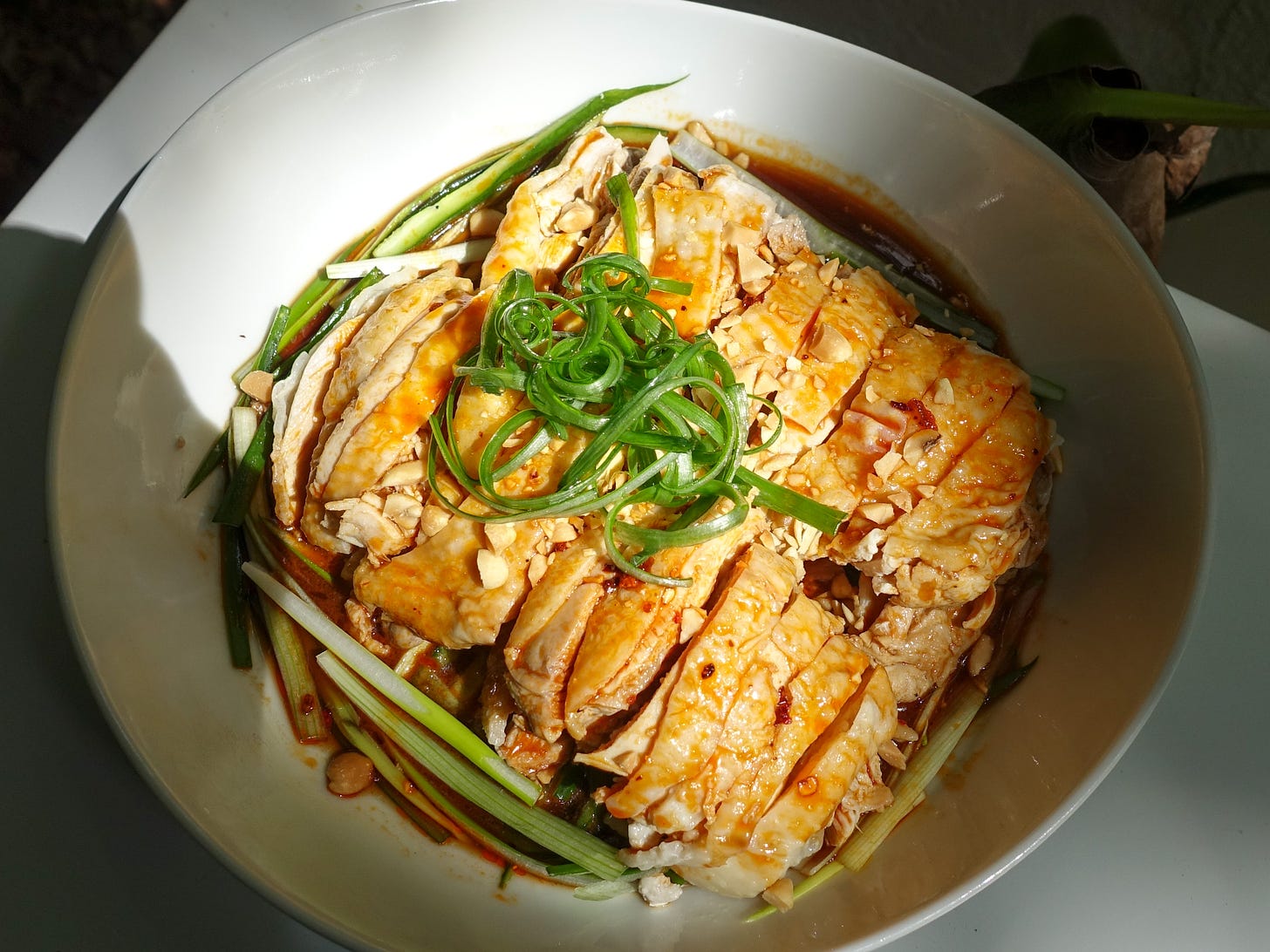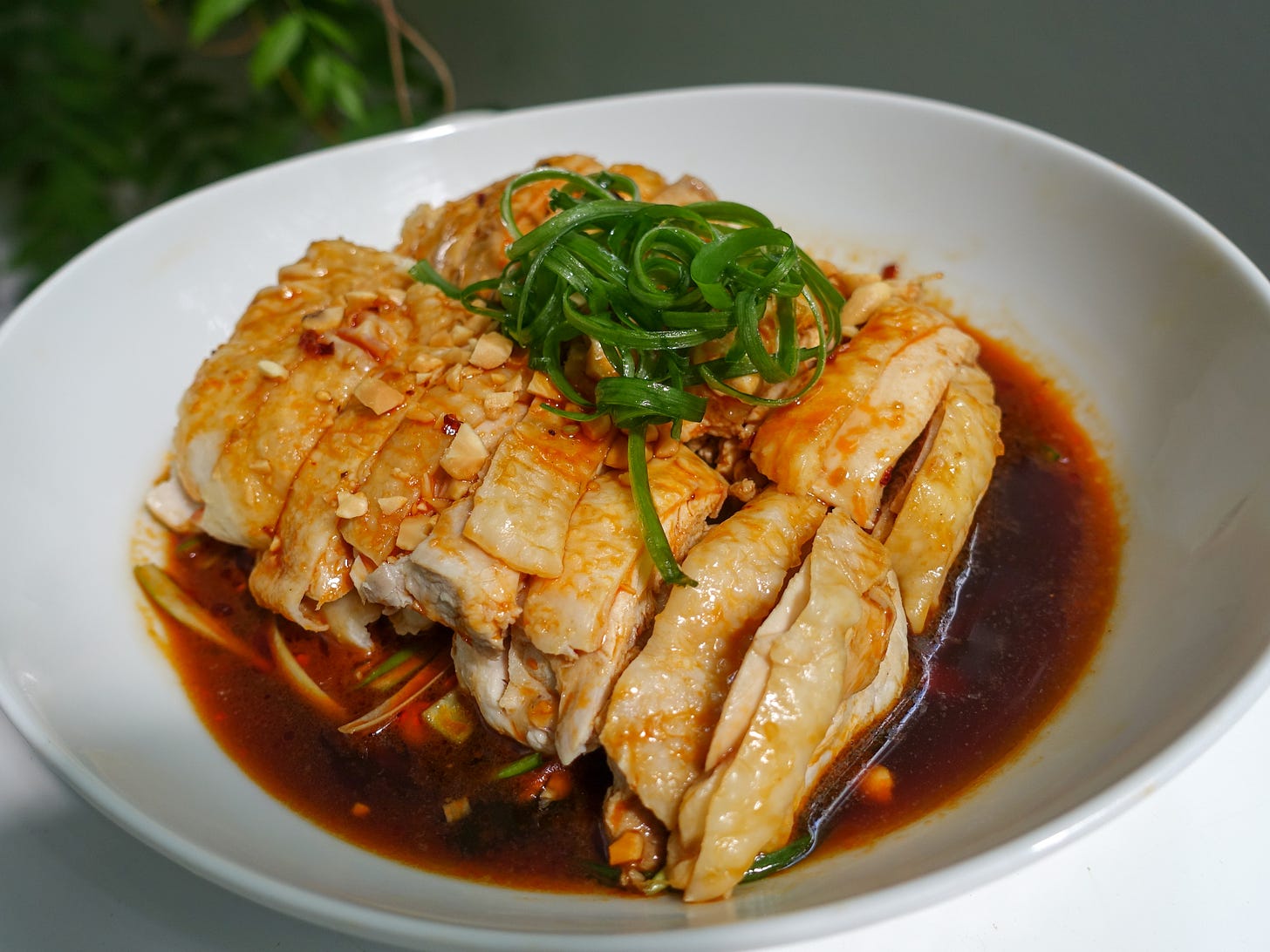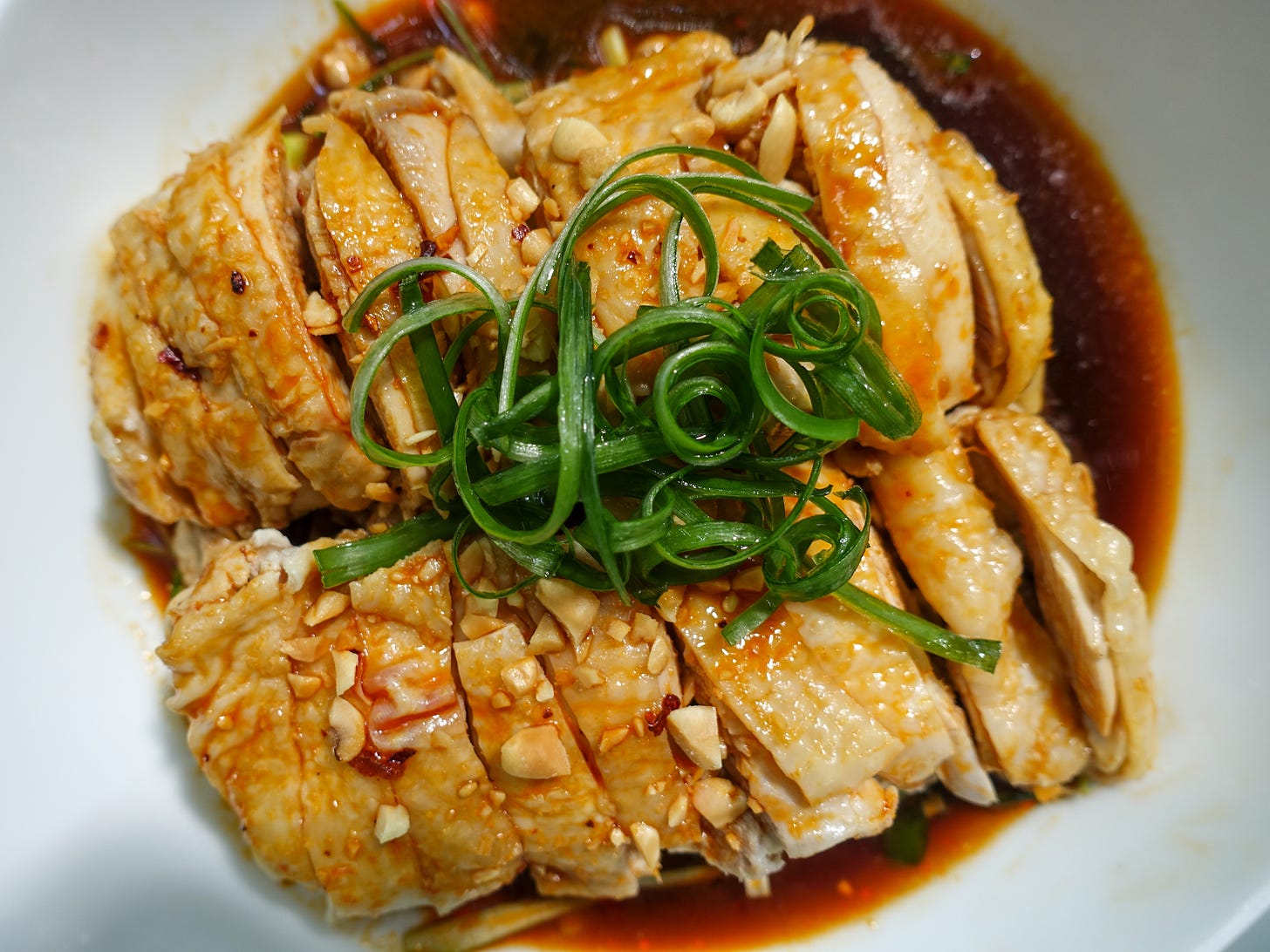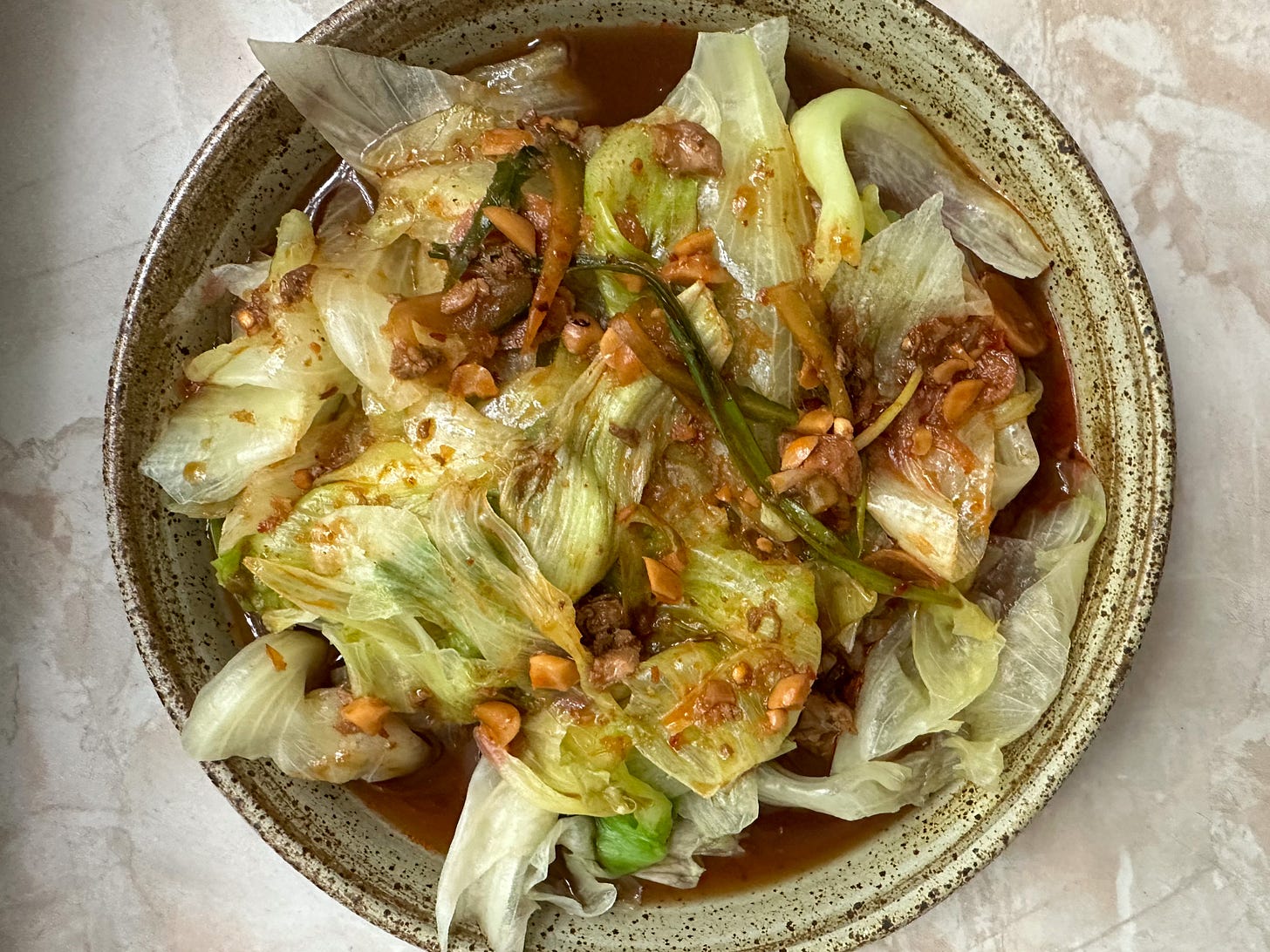Hey there! This week, I'm making a Chinese restaurant classic called kou shui ji, or mouth-watering chicken. It's perfect for the summer season and features the latest pantry item: Sichuan pepper, both whole Sichuan peppers and the oil is used in this recipe. Check out the video here!
In many generic Chinese restaurants here in Berlin, probably across Germany, the menu includes a standard selection of cold appetizers, among which stands a dish known as "saliva chicken." This term is a literal translation of "kou shui ji" (口水鸡), referring to a Sichuan-style cold-dressed chicken. I first noticed this translation when I went to the Chinese restaurant Shan Shan in Berlin with my friends a few years ago. Since then, I have noticed non-Chinese speakers finding the translation both amusing and confusing on a few occasions.
I assured them that there was no saliva involved, and this was rather another poor translation. Maybe "mouth-watering" would have been better. The name implies that the chicken is so delicious that it triggers salivation—a common Chinese saying to describe how delicious the food is. Some believe the name originated from the famous writer Guo Moruo’s (郭沫若) praise of a chicken dish that left him salivating when thinking about it.
This is more of a modern twist inspired by Sichuan classics. You'd find traditional variations such as strange-flavor or bangbang chicken, basically poached chicken dressed in a sauce based on chili oil. Bangbang chicken (棒棒鸡) is a whole chicken cooked and knocked with a stick (bang) to release the meat from the bone. In Chengdu, a popular deli chain my family frequents is called liaoji bangbang chicken (廖记棒棒鸡), offering a variety of cold meats such as beef, chicken, offals, dressed in a luscious chili oil sauce. They’re perfect for a quick dinner. The next day, the red oil sauce will be repurposed for salad dressing. Bangbang chicken emphasizes the generous use of chili oil and a real mala (spicy and numbing) taste.
The saliva chicken you get here is milder and similar to strange-flavor chicken(怪味鸡). Strange-flavor, or guaiwei (怪味), is a complex flavor that perfectly balances savory, sweet, tingling, spicy, sour, aromatic, and umami. This flavor originated from street vendors and is a favorite in cold appetizers. All the flavors harmonize without overpowering each other. However, the proportion of different components can be adjusted flexibly: You can add more chili oil, Sichuan pepper, or vinegar as per your preference.
The recipe
Servings: 2-3
Ingredients
To poach the chicken:
500g boneless, skin-on chicken thigh
2 slices of ginger
5 Sichuan peppercorns
1 tbsp Shaoxing wine
For the sauce:
3 tbsp aromatic sweet soy sauce (recipe)
3 cloves of garlic
1 tsp ginger
3-4 tbsp chili oil (recipe), adjust to preference
1 tsp sesame paste
1 tsp sesame oil
1/2 tbsp Chinese black vinegar (Chinkiang or Baoning)
1 tsp Sichuan peppercorn oil (or 1/2 tsp ground Sichuan pepper), adjust to preference
2 tsp sugar
2 tbsp reserved chicken stock
For assembly:
2 Persian cucumbers (weighs about 200g)
2 scallions
1 tbsp roasted peanuts, chopped
toasted white sesame seeds for garnish
Instructions:
Bring a pot of water to boil, then add the chicken thighs with ginger, Sichuan pepper and Shaoxing wine. Turn the heat to medium, poach over a light simmer for about 12-15 min until cooked but still juicy. Then turn the heat off, let the chicken sit in the water for 10 more minutes. Transfer to a bowl of iced water for 5 min. Reserve 2-3 tbsp chicken stock for the sauce and store the rest for other purposes.
While the chicken is cooking and cooling, thinly slice cucumbers and cut into strips about 6-8 cm long. Quarter the scallion lengthwise, then cut into thin strips of similar length. Reserve some scallion green for final garnish.
To make the sauce, finely grate ginger and garlic into a bowl, add about 1 tbsp water, mix together. In a bowl, add sesame paste and sesame oil, mix until smooth. Then add ginger-garlic water, sugar, Chinese black vinegar, chili oil, Sichuan pepper oil, and reserved chicken stock. Mix until well combined and the sugar is dissolved. If you want the sauce to be smooth, filter over a fine sieve. Taste the sauce to see if it needs anything more.
Slice the cooked chicken. On a plate, add cucumber and scallion strips on the bottom, then add sliced chicken pieces, drizzle the sauce. Scatter with chopped peanuts, scallion green. Serve with rice and other sides.
Tips to make the best mouth-watering chicken
Choosing and preparing the chicken: traditionally, this dish uses a whole chicken. During testing, I used bone-in chicken thighs and a whole corn-fed chicken; both worked pretty well (I enjoy the texture of the latter!). For the bone-in chicken pieces, you can remove the bones after cooling or use a cleaver to cut into small pieces, or tear them into small pieces with your hands. Chicken breast works too; however, be mindful of the cooking to keep it still juicy.
Aromatic soy sauce: I used the recipe from my sweet-water noodles, by simmering 250g soy sauce with 150g dark brown sugar, 100ml and some spices for about 30 min. Alternatively, you can use store-bought sweet soy sauce or directly mix soy sauce with dark brown sugar.
Sichuan pepper: whole Sichuan peppers are often used in poaching meat together with ginger and scallion to add aroma and remove unpleasant taste. In the dressing I used Sichuan pepper oil, but you can use ground pepper, or store-bought tengjiao oil. The numbing taste really varies depending on which you use, start with less and build more from there.
Sesame paste and oil: Sesame is not the major flavoring here, and some recipes skip the paste. The sesame paste is to thicken the sauce and makes it coat the chicken better. But a splash of sesame oil adds aroma, so I would keep it.
Vegetables: shredded scallion or leek is a classic choice, but I like some cucumber for the crunch. You can also add any raw vegetable such as radish, kohlrabi, carrots. Or skip it entirely.
Got extra sauce? I saved the sauce to dress a blanched lettuce salad the next day.







